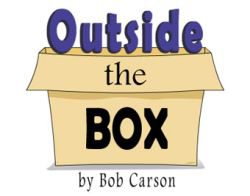Beta Tracking
September 23, 2019,Editor’s Note: The USTA website is pleased to present freelance writer Bob Carson and his popular “Outside the Box” features. This monthly series is a menu of outlandish proposals presented with a wink — but the purpose behind them is serious. The views contained in this column are that of the author alone, and do not necessarily represent the opinions or views of the United States Trotting Association.
A recent conversation with a wealthy, intelligent acquaintance surprised me. He is a serious, super smart person, a rabid sports fan with a very high interest in baseball, golf, and football. He is not averse to gambling on sports. I pressed him about giving our sport a try. His reply was interesting.
“You don’t realize how foolish I feel when exposed to horse racing. Even watching the Kentucky Derby on television with the changing odds, the pedigrees, the training, the racing, and the wagering strategies…for a person unfamiliar with racing, the experience is overwhelming. I feel like an idiot.”
I reminded him that other sports and games he followed were also complicated.
 He said, “I began to follow those sports from the cradle, they were on television and every broadcaster was a teacher. They were in the newspaper. Today they are on websites and videos. I played most of these sports and had a long learning curve. I did not need to go from one mile per hour to a hundred in a short period — and pay for it.”
He said, “I began to follow those sports from the cradle, they were on television and every broadcaster was a teacher. They were in the newspaper. Today they are on websites and videos. I played most of these sports and had a long learning curve. I did not need to go from one mile per hour to a hundred in a short period — and pay for it.”
This is a troublesome concept for those of us who enjoy our creaky old game. Unless you know a game, unless you have some level of confidence, why would you suddenly find an interest, participate, or gamble?
Trailing only soccer, cricket is the second most popular sport in the world, dwarfing baseball and football. Have you ever watched a cricket match? If you do, chances are that you will find the match boring and frustrating. You would not wager on the outcome. The only way you might watch again and eventually wager would be if you could sneak into cricket kindergarten for a few lessons. Then perhaps you would see what four billion cricket fans find so enticing.
The suggestion here is an experiment that the entire industry could get behind. Create a harness track for Beta-testing where my non-horse racing friend could visit and slowly learn the racing ABCs. Find (or build) a racetrack; we could even name it Beta Trotting and Pacing Park and reconfigure the racing program to a series of small fields that would race in rapid succession with ridiculously simple wagering.
For our experimental track and presentation, the emphasis will be on action, speed, and lots of “winning.” Interaction and fun will be paramount. We should attempt to create a site that is not in the least bit intimidating as we search for new players. This will be a new look for a new audience. Traditionalists and hard-core gamblers can simply ignore the silliness. For our regular customers, it will be business as usual. The radical experiment will not affect you.
It is no accident that almost all successful companies run Beta testing at a loss. They run experiments knowing that they will lose money and that any payoff is down the road. A harness racing Beta testing season of short fields (for visual purposes) and simple wagering at a fast pace may be a huge flop. The experiment may also be a huge hit. Most likely, the results will fall somewhere in between.
The hypothesis of the experiment will be that a certain segment (people intimidated at trying our sport) will find a much more friendly starting point. The internet offers us a wide net to search for potential players. When we find them, we should create a wading pool where my friend, Aunt Sally at the beauty shop, or Gary the Gamer can stick their toes into the harness racing waters.
Logistically, the Beta test track would not require massive retooling for this type of experiment. The same number of horses, racing for the same amount of money could be the base parameter. The difference would be how the horses, owners, and trainers race for the money and how the customer’s gamble.
The test track will be harness horse racing pre-school, a safe, non-threatening oasis. The presenters should assume that visitors know nothing about trotting and pacing races. New visitors will be skittish and need nurturing. Things we take for granted like where the race starts and ends, why the driver leans back, what a pocket trip is, and why the horses wear all that equipment should be explained in an entertaining style and revisited often.
The wagering at this test track should be incredibly simple, perhaps simply win tickets, or perhaps make the wager odd or even. The strange idea is not to create huge revenue, at least at this phase, the idea is for harness racing to create interest and learn if new markets exist.
A Beta test track could be a rallying cry for the industry, something new for all who hope for a bright future. We could all be missionaries and send friends to this kindergarten of racing.
The results are TBD. Should our entire industry or a brave racetrack give this innovative effort an honest attempt for a season, we could run the numbers and use them for predictive modeling. There are no guarantees in Beta testing, but there is little to lose and much to gain.

